Why Wear Golf Gloves?

The Comprehensive Guide to the Importance of Golf Gloves
Golf is a game where even the smallest details can have a significant impact on your performance. From the choice of clubs and balls to techniques and accessories, every aspect can help you improve your game and lower your score.
Among these often-overlooked accessories, the Golf Glove stands out as a simple yet essential piece of equipment that has become a standard for most golfers, from amateurs to professionals.
While not mandatory, Golf Gloves have grown in popularity because of the tangible benefits they offer during play.
Whether you are new to golf, play recreationally, or are a seasoned golfer, wearing a golf glove could offer you that slight edge needed to improve your grip, protect your hands, and enhance your overall performance.
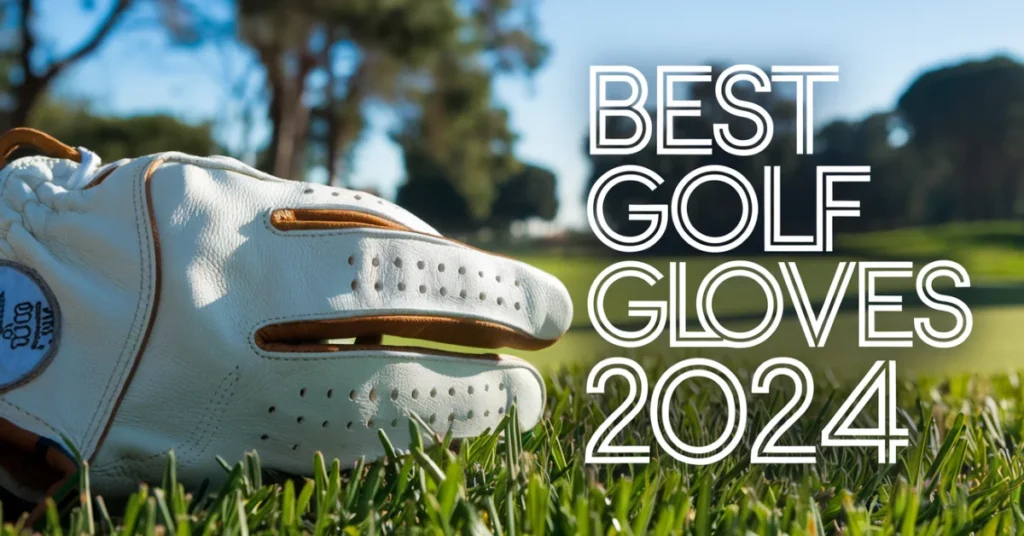
Also Read This Article: Best Golf Gloves 2024
But why exactly do golfers wear gloves?
What advantages do they offer?
In this comprehensive article, we will explore the reasons why wearing golf gloves can be beneficial, the science behind their design, and how they contribute to the modern golfing experience.
We will delve into the specific details surrounding the use of golf gloves, answering common questions such as why golfers wear one glove, which hand the glove is worn on, and whether wearing gloves for all shots is advisable.
Related Article: Best Golf Stand Bags 2024
1. Introduction to Golf Gloves
Golf gloves are typically made from a combination of leather and synthetic materials, designed to provide golfers with a more secure grip on the club, as well as added comfort and protection.
In addition to their functional benefits, they have become a familiar part of the golf attire and routine, contributing to a player’s confidence and sense of readiness.
Golfers typically wear one glove, but some players opt for two gloves, depending on their preferences and the weather conditions.
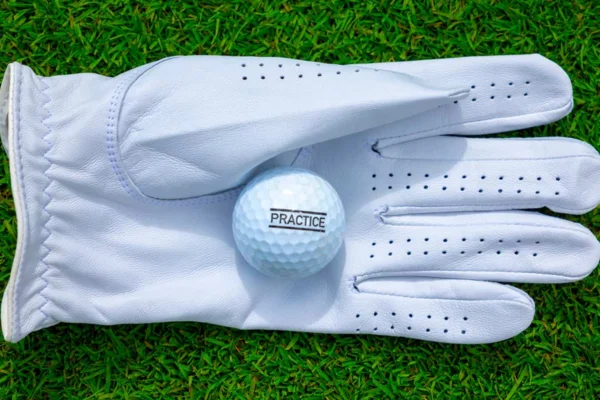
The glove is usually worn on the golfer’s non-dominant hand (i.e., the left hand for right-handed golfers and the right hand for left-handed golfers), which is responsible for the majority of the gripping pressure.
The use of golf gloves became common in the mid-20th century, and today, they are considered an essential part of a golfer’s gear.
While some purists may choose to play without gloves, the vast majority of golfers find that the benefits far outweigh any downsides.
But what exactly are the reasons behind wearing a golf glove?
Related Article: Best Golf Carts for 2024
2. Why Do Golfers Wear One Glove?
If you observe professional golfers, you’ll notice that most wear only one glove, usually on their non-dominant hand.
The choice to wear just one glove is not arbitrary but stems from how golfers grip and control their clubs.
The non-dominant hand (the left hand for right-handed golfers) is considered the “lead hand” in a golf swing. T
his hand holds the club at the top of the grip and does most of the work when controlling the club. The glove on this hand provides additional grip and prevents the club from slipping during a swing.
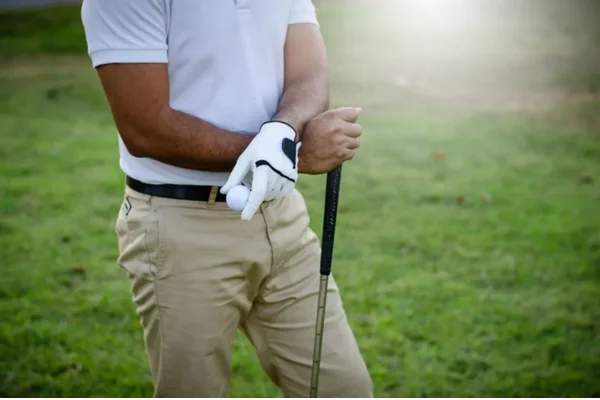
In contrast, the dominant hand is more involved in guiding the club, so golfers often prefer the tactile feedback of bare skin to help with their precision and control.
For many golfers, wearing two gloves can interfere with their feel of the club.
The feedback you get from gripping the club with your bare hand, especially for the trailing hand (the dominant hand), can be crucial when making accurate shots.
However, some golfers do wear two gloves, especially in challenging weather conditions like heavy rain or extreme cold, where the focus is more on staying warm and maintaining a secure grip.
Related Article: Best Golf Balls for Beginners 2024
3. Benefits of Wearing Golf Gloves
3.1. Grip
One of the primary reasons golfers wear gloves is for the enhanced grip they provide. Gripping a golf club can be challenging, especially if your hands are sweaty or if you’re playing in damp or rainy conditions.
The slick surface of the club can lead to slips, causing mis-hits or inconsistent shots.
A golf glove helps mitigate this by increasing friction between the club and your hand.
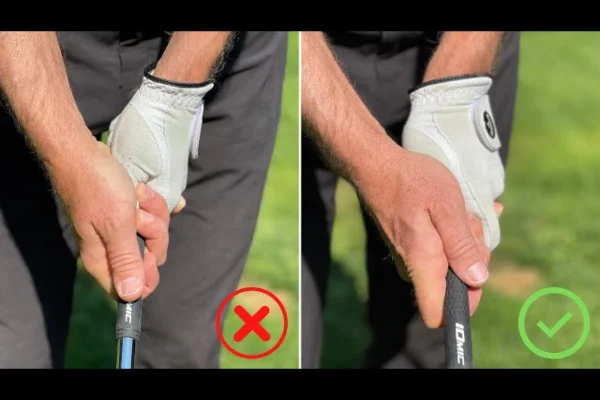
This allows you to maintain a secure grip without needing to squeeze the club too tightly.
Over-gripping the club can lead to tension in your hands, arms, and shoulders, ultimately affecting your swing mechanics and distance control.
Gloves allow you to grip the club more lightly while maintaining control, resulting in a smoother, more fluid swing.
3.2. Protection
Swinging a golf club hundreds of times during a round can take a toll on your hands, especially if you have sensitive skin or if you grip the club too tightly.
Repeated friction between your hands and the club can lead to painful blisters and callouses, making it uncomfortable to play.
A golf glove acts as a barrier between your skin and the grip of the club, reducing the friction that causes these issues.
This protection is particularly important during long practice sessions on the driving range or when playing multiple rounds of golf in a short period.
With a glove, you can focus more on your game and less on the discomfort of irritated hands.
Related Article: Best Golf Balls for Seniors 2024
3.3. Moisture Control
Sweaty hands are a common problem for golfers, especially in hot or humid conditions.
Excess moisture can make it difficult to maintain a firm grip on the club, leading to slips and mishits.
Golf gloves, especially those made from moisture-wicking materials, help absorb sweat and keep your hands dry throughout your round.
This is crucial for maintaining consistent performance, as a dry grip allows for better control of the club and more accurate shots.
In addition to sweat, gloves also help in rainy conditions by keeping your hand dry and preventing the club from slipping.
Some gloves are specifically designed for wet weather and feature materials that provide extra grip even when wet, ensuring you maintain control no matter the conditions.
3.4. Warmth in Cold Weather
Golf is played year-round in many parts of the world, and players often have to contend with cold weather during the fall and winter months.
Cold hands can quickly become stiff and unresponsive, making it difficult to grip the club and execute your shots with precision.
A golf glove helps keep your hand warm by providing an extra layer of insulation.
Some players opt to wear winter-specific golf gloves, which are designed with thicker materials and added thermal protection.
These gloves are essential for maintaining dexterity and control when the temperature drops, ensuring that your performance doesn’t suffer in colder conditions.
4. What Hand Do You Wear a Golf Glove On?
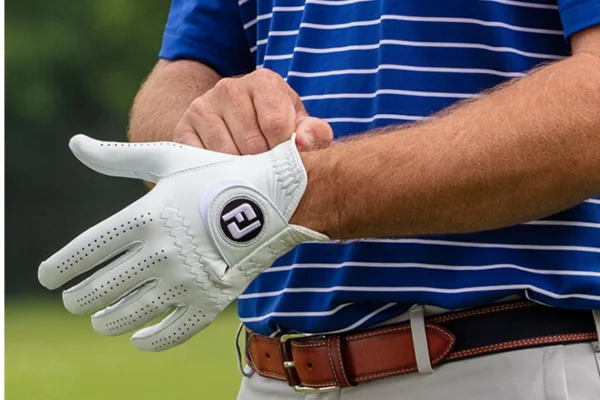
For new golfers, one of the most common questions is, “Which hand do I wear my golf glove on?”
The answer is simple: if you are a right-handed golfer, you wear the glove on your left hand.
If you are a left-handed golfer, you wear the glove on your right hand.
The reason behind this is that your non-dominant hand, or “lead hand,” is responsible for gripping the club more tightly and providing the majority of the control during your swing.
The lead hand is positioned at the top of the club, and it is the hand that benefits most from the added grip and protection provided by a golf glove.
The dominant hand, or “trail hand,” is more involved in guiding the club through the swing.
Many golfers prefer to leave their trail hand bare to maintain the tactile feel and feedback necessary for precise control.
However, as previously mentioned, some golfers choose to wear two gloves, especially in extreme weather conditions, where grip and warmth take priority over feel.
5. Should You Wear a Golf Glove for All Shots?
Whether or not to wear a glove for every shot comes down to personal preference. Most golfers wear a glove for all full-swing shots, including drivers, woods, irons, and wedges.
The added grip and protection offered by the glove are invaluable when swinging at high speeds, as they help maintain control and prevent slippage.
However, when it comes to putting, many golfers choose to remove their glove.
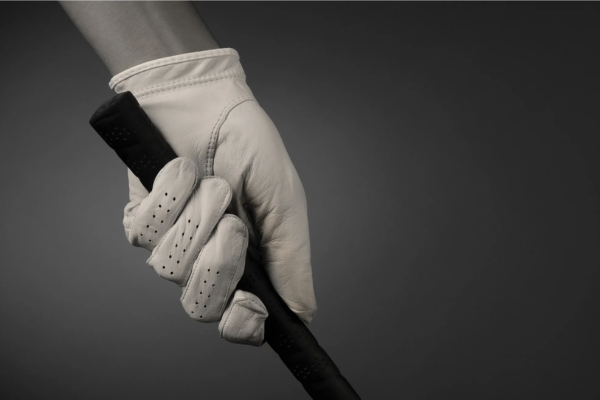
Putting is a delicate part of the game that requires precision and feel, and the theory is that removing the glove allows for a more direct connection between the hands and the club.
With the glove off, golfers can better sense the weight of the putter and the speed of the greens, allowing for more accurate putts.
That being said, there are no hard-and-fast rules about wearing a glove while putting. Some professional golfers, including the legendary Jack Nicklaus, prefer to leave their glove on for all shots, including putting.
The decision ultimately comes down to what feels most comfortable and effective for you.
6. The Evolution of Golf Gloves
Golf gloves have not always been a standard part of the game. In fact, early golfers played without them, relying on their bare hands to grip the club.
It wasn’t until the mid-20th century that golf gloves began to gain popularity, thanks to advances in materials and design.
Early golf gloves were primarily made from leather, which provided a good grip but lacked the durability and moisture-wicking properties of modern gloves.
Over time, manufacturers began experimenting with synthetic materials and blends, creating gloves that were more comfortable, durable, and suited to a variety of weather conditions.
Today, golf gloves are available in a wide range of styles, materials, and designs, catering to golfers of all skill levels and preferences.
Whether you’re looking for a glove that offers maximum grip in wet conditions, extra warmth for cold-weather play, or a glove that prioritizes feel and comfort, there is a glove out there for you.
7. The Importance of Fit and Comfort
When it comes to golf gloves, fit and comfort are crucial. A glove that is too tight can restrict your movement and cause discomfort, while a glove that is too loose can reduce your grip and lead to slippage.
The ideal golf glove should fit snugly but not feel constricting. It should conform to the shape of your hand, with no excess material bunching up in the fingers or palm.
When trying on a glove, make sure that it feels secure but allows for a full range of motion in your fingers and wrist.
Comfort is also important, as you’ll be wearing the glove for long periods of time.
Look for gloves made from breathable materials that wick away moisture and prevent your hand from becoming too sweaty.
If you play in hot or humid conditions, consider gloves with mesh or perforated panels for added ventilation.
Finally, pay attention to the closure mechanism. Most golf gloves feature a Velcro strap that allows you to adjust the fit around your wrist.
This is important for ensuring a secure fit and preventing the glove from slipping during your swing.
8. Materials Used in Golf Gloves
The materials used in golf gloves can have a significant impact on their performance and durability.
Most golf gloves are made from a combination of leather and synthetic materials, each of which offers its own advantages.
Leather
Leather is the most common material used in golf gloves, particularly for the palm and fingers.
Leather provides a soft, comfortable feel and offers excellent grip, especially when it comes to maintaining control of the club.
The most popular type of leather used in golf gloves is Cabretta leather, which is known for its durability, flexibility, and resistance to moisture.
However, leather gloves can become stiff if they get too wet, and they may require more maintenance than synthetic gloves.
It’s also important to note that leather gloves tend to be more expensive than their synthetic counterparts.
Synthetic Materials
Synthetic materials are often used in combination with leather to create golf gloves that are more affordable, durable, and resistant to moisture.
Synthetic gloves are typically lighter and more flexible than leather gloves, making them a popular choice for golfers who prioritize comfort and breathability.
One of the main advantages of synthetic gloves is their ability to wick away moisture, making them ideal for use in hot or humid conditions.
Many synthetic gloves also feature reinforced areas on the palm and fingers to enhance durability and grip.
Hybrid Gloves
Some golf gloves combine leather and synthetic materials to offer the best of both worlds.
These “hybrid” gloves typically feature leather on the palm and fingers for added grip and feel, while synthetic materials are used on the back of the hand for increased breathability and flexibility.
Hybrid gloves are a great option for golfers who want the performance of leather with the comfort and affordability of synthetic materials.
9. Types of Golf Gloves: Regular vs. Winter and Rain Gloves
In addition to the standard golf glove, there are specialized gloves designed for specific weather conditions.
These gloves are essential for golfers who play in rain, cold, or extreme heat, as they offer additional features to help you perform at your best.
Rain Gloves
Rain gloves are designed to provide maximum grip in wet conditions. Unlike regular gloves, which can become slippery when wet, rain gloves are made from materials that actually increase their grip when exposed to moisture.
This allows you to maintain control of your club even in heavy rain.

Rain gloves are typically worn on both hands, as wet conditions can affect your grip on both the lead and trail hands.
These gloves are a must-have for golfers who frequently play in rainy climates or who want to be prepared for unexpected weather changes during a round.
Winter Gloves
Winter Golf Gloves are designed to keep your hands warm in cold weather while still providing the grip and control you need to play your best.
These gloves are made from thicker, insulated materials that help retain heat, and they often feature fleece linings or thermal technologies to keep your hands comfortable.
Like rain gloves, winter gloves are usually worn on both hands to provide maximum warmth and protection.
Some golfers even wear winter gloves as a precaution in cooler temperatures, ensuring that their hands stay warm and flexible throughout the round.

Also Read This Article: Best Winter Golf Gloves 2024
10. Caring for Your Golf Gloves
Proper care and maintenance are essential for extending the life of your golf gloves and ensuring they continue to perform at their best.
Here are some tips for taking care of your golf gloves:
- Clean Regularly: After each round, wipe down your glove with a damp cloth to remove dirt, sweat, and oils. Avoid using harsh chemicals or abrasive materials, as these can damage the leather or synthetic materials.
- Air Dry: If your glove becomes wet during play, allow it to air dry naturally. Avoid exposing it to direct sunlight or using a heat source, as this can cause the materials to become stiff or brittle.
- Rotate Gloves: If you play frequently, consider rotating between multiple gloves to prevent excessive wear and tear on a single glove. This can also help prevent the buildup of moisture and prolong the life of each glove.
- Store Properly: Store your gloves in a cool, dry place, away from direct sunlight or extreme temperatures. You can also use a glove keeper or glove shaper to help maintain the shape of the glove and prevent it from becoming creased or misshapen.
By following these simple care tips, you can keep your golf gloves in top condition and ensure they continue to provide the grip, comfort, and protection you need.
11. Factors to Consider When Choosing a Golf Glove
When choosing a golf glove, there are several factors to consider, including fit, material, durability, and weather conditions. Here are some key points to keep in mind:
- Fit: A well-fitting glove should be snug but not tight, with no excess material bunching up in the fingers or palm. Make sure you have full range of motion in your fingers and wrist.
- Material: Leather gloves offer superior grip and feel, while synthetic gloves are more affordable and breathable. Consider a hybrid glove if you want the best of both worlds.
- Durability: Look for gloves with reinforced areas on the palm and fingers, as these are the areas most prone to wear and tear.
- Weather Conditions: If you frequently play in rain or cold weather, invest in specialized rain or winter gloves to ensure you stay comfortable and maintain a secure grip.
- Price: Golf gloves come in a wide range of prices, so choose a glove that fits your budget without sacrificing quality.
By considering these factors, you can find the perfect glove to suit your needs and enhance your performance on the course.
12. Professional Golfers and Their Preferences
Many professional golfers have specific preferences when it comes to gloves. Some prefer the feel of leather gloves, while others opt for synthetic materials or hybrids.
Some pros, like Jack Nicklaus, wear a glove for every shot, including putting, while others remove their glove when on the green.
Regardless of their individual preferences, all professionals recognize the importance of a well-fitting, high-quality glove for maintaining control and consistency throughout their game.
13. Conclusion: Enhancing Your Golf Game with the Right Glove
Wearing a golf glove is not just about tradition or appearance – it’s about enhancing your grip, protecting your hands, and improving your overall performance.
Whether you’re a beginner or a seasoned pro, the right golf glove can make a significant difference in your game.
By understanding the benefits of wearing a golf glove, choosing the right materials, and ensuring a proper fit, you can maximize your comfort and control on the course.
From protecting against blisters and callouses to maintaining a secure grip in all weather conditions, a golf glove is an essential piece of equipment that no golfer should overlook.
So the next time you step onto the course, make sure you’re wearing the right glove – it might just be the key to taking your game to the next level.
